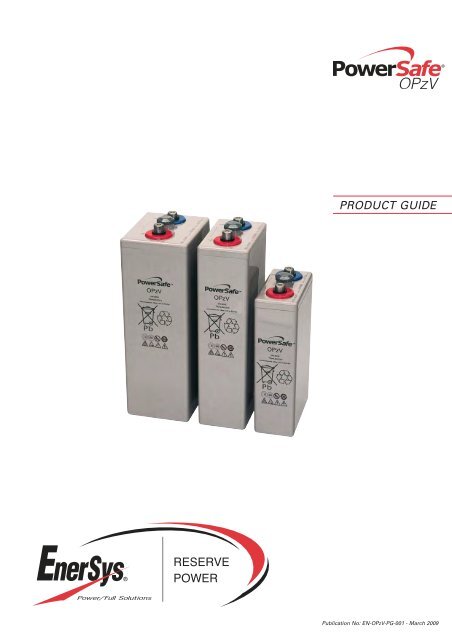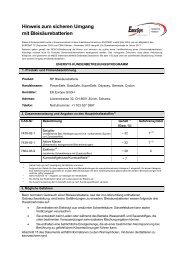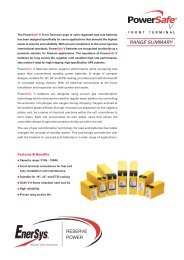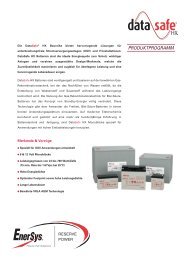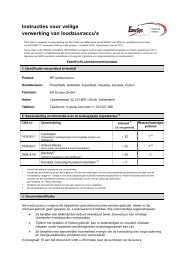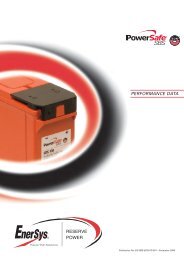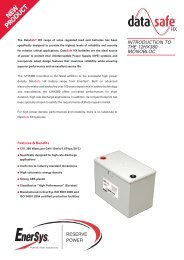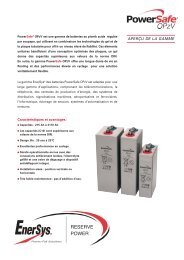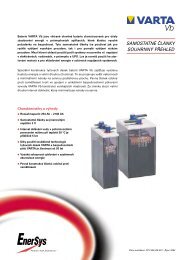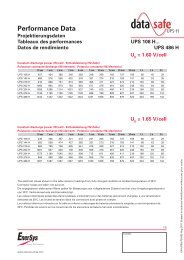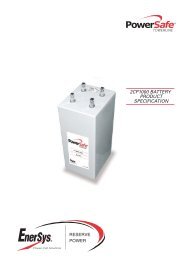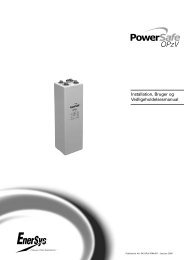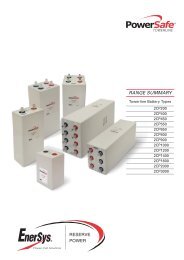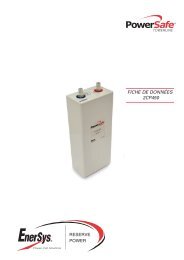Product Guide - Enersys - EMEA
Product Guide - Enersys - EMEA
Product Guide - Enersys - EMEA
Create successful ePaper yourself
Turn your PDF publications into a flip-book with our unique Google optimized e-Paper software.
RESERVE<br />
POWER<br />
PRODUCT GUIDE<br />
Publication No: EN-OPzV-PG-001 - March 2009
I/ The principle of the gas recombination tubular gel battery<br />
1 - Operating principle ......................................................................................................................................................................................................................................................................................................... 3<br />
2 - Conclusion .......................................................................................................................................................................................................................................................................................................................................................... 3<br />
3 - Construction ................................................................................................................................................................................................................................................................................................................................................ 4<br />
4 - The PowerSafe ® OPzV Battery range .................................................................................................................................................................................................. 5<br />
II/ Application and use of the PowerSafe ® OPzV battery<br />
1 - Standby applications .............................................................................................................................................................................................................................................................................................. 6<br />
2 - Battery cycling .................................................................................................................................................................................................................................................................................................................................... 8<br />
3 - Effect of temperature on battery capacity ..................................................................................................................................................................... 8<br />
4 - Temperature range .......................................................................................................................................................................................................................................................................................................... 8<br />
5 - Effect of temperature on life .................................................................................................................................................................................................................................................... 8<br />
III/ Electrical performance at 20°C .................................................................................................................................................................................................... 9 to 17<br />
IV/ Battery calculations ..................................................................................................................................................................................................................................................................................................... 18<br />
V/ Installation of the battery<br />
1 - Warning ................................................................................................................................................................................................................................................................................................................................................................... 19<br />
2 - Unpacking the battery ................................................................................................................................................................................................................................................................................ 19<br />
3 - Setting up the battery stands ....................................................................................................................................................................................................................................... 19<br />
4 - Connection of the cells ............................................................................................................................................................................................................................................................................ 23<br />
5 - General recommendations .................................................................................................................................................................................................................................................... 23<br />
6 - Safety ................................................................................................................................................................................................................................................................................................................................................................................. 23<br />
7 - Standards ......................................................................................................................................................................................................................................................................................................................................................... 23<br />
VI/ Battery storage<br />
1 - Calculating the storage time ............................................................................................................................................................................................................................................ 24<br />
2 - Storage conditions .................................................................................................................................................................................................................................................................................................... 24<br />
3 - Storage times .................................................................................................................................................................................................................................................................................................................................. 24<br />
4 - Recharging stored batteries .............................................................................................................................................................................................................................................. 24<br />
5 - State of charge ........................................................................................................................................................................................................................................................................................................................... 24<br />
VII/ Commissioning charge .......................................................................................................................................................................................................................................................................... 25<br />
VIII/ Maintenance/checks ......................................................................................................................................................................................................................................................................................<br />
www.enersys-emea.com<br />
Contents<br />
Page<br />
25<br />
Publication No: EN-OPzV-PG-001 - March 2009<br />
1
Introduction<br />
The principle of gas recombination, which limits the release of gas, allows<br />
the batteries to be installed in the widest possible range of sites ensures it is<br />
compatible with modern technology.<br />
The purpose of this operating guide is to provide you with technical<br />
information to gain a better understanding of the PowerSafe ® OPzV battery<br />
gas-recombination range and will enable you to use it more effectively.<br />
2 www.enersys-emea.com<br />
Publication No: EN-OPzV-PG-001 - March 2009
I/ The principle of the gas<br />
recombination tubular gel battery<br />
1 - Operating principle<br />
In a traditional lead – acid battery, overcharging<br />
leads to a release of hydrogen and oxygen, a certain<br />
amount of water is lost and has to be replaced<br />
regularly by topping up.<br />
In a gas recombination battery, the internal design<br />
of the cell allows the oxygen produced at the<br />
positive plates to diffuse toward the negative plates<br />
:<br />
- The oxygen reacts chemically with the<br />
spongy lead of the active material to form<br />
lead oxide.<br />
- The sulphuric acid of which the electrolyte is<br />
composed then reacts with this lead oxide to<br />
form lead sulphate and water.<br />
- The lead sulphate thus formed is transformed<br />
electro-chemically into lead, to return<br />
sulphuric acid.<br />
- As long as the battery remains fully charged,<br />
this equilibrium is maintained.<br />
Conventional cell<br />
Oxygen and Hydrogen<br />
escape to the<br />
atmosphere<br />
2 - Conclusion<br />
Due to the gas recombination reaction in the PowerSafe ®<br />
OPzV battery, water is recombined nearly at the same rate<br />
as it is consumed under float charge conditions and no<br />
topping up water during the lifetime of the cells is required.<br />
www.enersys-emea.com<br />
Schematically, we then have the following reactions :<br />
At the end of the charge or if<br />
overcharging, oxygen gas<br />
is released at the positive<br />
plate.<br />
The oxygen diffuses across<br />
the gelled electrolyte and<br />
the micro-porous separator<br />
to the negative plate.<br />
The oxygen reacts chemically<br />
with the spongy lead of the<br />
negative plate to form lead<br />
oxide.<br />
The sulphuric acid reacts with<br />
this lead oxide, giving lead<br />
sulphate and water.<br />
Part of the spongy lead is thus<br />
chemically discharged to the<br />
lead sulphate state and the<br />
water consumed at the<br />
positive plate is regenerated.<br />
The spongy lead which was<br />
chemically discharged at the<br />
negative plate is recharged<br />
chemically.<br />
H 2 O ➞ 2H + + 1/2O 2 + 2e -<br />
Pb + 1/2O 2 ➞ PbO<br />
PbO + H 2 SO 4 ➞ PbSO 4 + H 2 O<br />
PbSO 4 + 2H + + 2e -<br />
➞ Pb + H 2 SO 4<br />
PowerSafe ® OPzV battery<br />
Oxygen evolved from<br />
positive plate<br />
transfers to negative<br />
and recombines to<br />
form water.<br />
Publication No: EN-OPzV-PG-001 - March 2009<br />
3
3 - Construction<br />
These reactions can take place only by using :<br />
- plates composed of a special lead calcium alloy<br />
which provides the grids with high mechanical<br />
strength and a high level of hydrogen overtension.<br />
- microporous separators<br />
Coloured negative<br />
polarity washer<br />
(blue)<br />
Lid in ABS<br />
Pressure relief valve<br />
Separator<br />
Flat negative<br />
plate<br />
- A capillary network gelled electrolyte :<br />
To retain the electrolyte in a thixotropic gel<br />
To help oxygen penetration into the negative plate.<br />
- A pressure relief valve which allows gas to be<br />
released if necessary in the case of an accidental<br />
overcharge.<br />
Terminals with brass<br />
insert for improved<br />
conductivity<br />
Coloured positive<br />
polarity washer (red)<br />
Tubular<br />
positive plates<br />
Diecast tabs<br />
of positive grid<br />
Positive grid<br />
coating<br />
Container in ABS<br />
4 www.enersys-emea.com<br />
Publication No: EN-OPzV-PG-001 - March 2009
4 - The PowerSafe ® OPzV Battery range<br />
Comprises 14 cells with capacities from 200 Ah to 3000 Ah.<br />
Type<br />
designation<br />
No Capacity<br />
of Ah<br />
terminal acc. to<br />
per pole DIN 40742<br />
Capacity Ah<br />
C10 C8 C5<br />
at final voltage<br />
C3 C1<br />
1.80V 1.75V 1.77V 1.75V 1.67V<br />
Internal<br />
resistance<br />
(m ohm<br />
/cell)<br />
Dimensions (mm)<br />
4 OPzV 200 1 200 215 210 190 170 130 0.95 2195 103 206 403 19.5 4 OPzV 200<br />
5 OPzV 250 1 250 265 260 235 210 160 0.76 2737 124 206 403 23.5 5 OPzV 250<br />
6 OPzV 300 1 300 320 315 285 255 195 0.66 3175 145 206 403 28.0 6 OPzV 300<br />
5 OPzV 350 1 350 385 375 340 305 230 0.61 3410 124 206 520 31.0 5 OPzV 350<br />
6 OPzV 420 1 420 460 450 410 365 275 0.51 4043 145 206 520 36.5 6 OPzV 420<br />
7 OPzV 490 1 490 540 525 475 430 320 0.45 4607 166 206 520 42.0 7 OPzV 490<br />
6 OPzV 600 1 600 705 680 615 545 395 0.55 3796 145 206 695 50.0 6 OPzV 600<br />
8 OPzV 800 2 800 940 910 820 730 525 0.40 5200 210 191 695 68.2 8 OPzV 800<br />
10 OPzV 1000 2 1000 1170 1135 1020 915 655 0.32 6460 210 233 695 82.0 10 OPzV 100<br />
12 OPzV 1200 2 1200 1410 1370 1225 1095 790 0.27 7675 210 275 695 97.0 12 OPzV 120<br />
12 OPzV 1500 2 1500 1580 1530 1395 1260 890 0.28 7510 210 275 845 120.0 12 OPzV 1500<br />
16 OPzV 2000 3 2000 2110 2040 1855 1680 1190 0.21 10048 212 397 820 165.0 16 OPzV 2000<br />
20 OPzV 2500 4 2500 2640 2550 2320 2100 1485 0.17 12606 212 487 820 200.0 20 OPzV 2500<br />
24 OPzV 3000 4 3000 3170 3065 2785 2515 1785 0.14 14964 212 576 820 240.0 24 OPzV 3000<br />
Short<br />
circuit<br />
current<br />
All dimensions and weights shown are subject to the usual manufacturing tolerances<br />
Height shown is overall height, including connectors and shrouds.<br />
4 OPzV 200 -<br />
6 OPzV 600<br />
www.enersys-emea.com<br />
8 OPzV 800 -<br />
12 OPzV 1500<br />
Length Width Height<br />
Weight<br />
(kg) cell<br />
16 OPzV 2000 20 OPzV 2500 -<br />
24 OPzV 3000<br />
Type<br />
Publication No: EN-OPzV-PG-001 - March 2009<br />
5
II/ Application and use of the<br />
PowerSafe ® OPzV batteries<br />
The application possibilities are multiple - as back–up supplies in<br />
telecom-munications, telephony, power generating stations and distribution<br />
systems, railway, airport or seaport signalling, computing, lighting, the<br />
armed forces, in the medical field, etc. - giving independent operation<br />
between 1 hour and 24 hours to such installations.<br />
1 - Standby applications<br />
1-1 Float voltage :<br />
The batteries are kept under a floating voltage of<br />
2.23 volts per cell at a temperature of 20°C<br />
(tolerance 2.23-2.25 Vpc.<br />
This float voltage should be set to match the<br />
prevailing temperature, in accordance with the<br />
following table.<br />
Temperature (C°) Float voltage (volt)<br />
-10°C<br />
0°C<br />
10°C<br />
20°C<br />
30°C<br />
40°C<br />
2.37 Vpc<br />
2.33 Vpc<br />
2.29 Vpc<br />
2.25 Vpc<br />
2.23 Vpc<br />
2.21 Vpc<br />
Due to the phenomena of gas recombination a<br />
difference of ± 4.5 % for an individual cell voltage<br />
can be observed.<br />
However the total voltage of the battery shall be<br />
within the limits stated above.<br />
1-2 Charging Current :<br />
Limitation of the charging current is not required<br />
under float charge condition at 2.25 Vpc. At higher<br />
charge voltages the charge current shall be limited<br />
to 0.4C10. 1.3 Discharging : End of discharge voltage<br />
according to the discharge time<br />
Discharge Time (t) End voltage (volt)<br />
1 h < t < 5 h<br />
5 h < t < 8 h<br />
8 h < t < 24 h<br />
1.70 V<br />
1.75 V<br />
1.80 V<br />
Although the tables of characteristics show end<br />
voltages down to 1.60 volts, the voltage values<br />
shown above are recommended in order to avoid a<br />
too-deep discharge of the battery.<br />
6 www.enersys-emea.com<br />
Publication No: EN-OPzV-PG-001 - March 2009
1.4 Recharging :<br />
The PowerSafe ® OPzV battery should be recharged<br />
by using a unique floating and recharge voltage at<br />
2.23-2.25 V/cell at 20°C. No current limitation is<br />
required in the majority of application cases.<br />
Percentage<br />
discharge<br />
10%<br />
30%<br />
50%<br />
80%<br />
100%<br />
* Note :<br />
If the charger does not permit an<br />
adjustment of the float voltage in<br />
relation with the temperature, it is<br />
possible to set a float voltage value in<br />
recharging voltage value according to<br />
the temperature ranges as indicated in<br />
the table hereafter.<br />
1.5 Ripple current :<br />
Unacceptable levels of ripple current from the<br />
charger of the load can cause permanent damage<br />
and a reduction in service life. It is recommended to<br />
If the PowerSafe OPzV battery has to be charged<br />
more quickly, a recharge voltage of 2.35 volts (boost<br />
charge) per cell can be used with current limited to<br />
0.4C 10<br />
Mean charging time in accordance with percentage discharge and recharging voltage<br />
per cell with current limited to 0.4C10<br />
Recharging<br />
voltage<br />
2.23V<br />
2.35V<br />
Recharging voltage according to temperature :<br />
www.enersys-emea.com<br />
2.23V<br />
2.35V<br />
2.23V<br />
2.35V<br />
2.23V<br />
2.35V<br />
2.23V<br />
2.35V<br />
State of charge<br />
50% 60% 70% 80% 90% 95% 100%<br />
-<br />
-<br />
-<br />
-<br />
-<br />
-<br />
1 h 00<br />
1 h 00<br />
2 h 00<br />
2 h 00<br />
-<br />
-<br />
-<br />
-<br />
0 h 45<br />
0 h 30<br />
1 h 30<br />
1 h 30<br />
2 h 30<br />
2 h 30<br />
-<br />
-<br />
-<br />
-<br />
1 h 30<br />
1 h 15<br />
3 h 00<br />
2 h 30<br />
4 h 30<br />
4 h 00<br />
-<br />
-<br />
1 h 15<br />
1 h 00<br />
4 h 00<br />
3 h 00<br />
7 h 00<br />
5 h 00<br />
10 h 00<br />
7 h 15<br />
Temperature (C°) Charging voltage (volt)<br />
0°C<br />
10°C<br />
20°C<br />
30°C<br />
35°C<br />
Temperature<br />
(C°)<br />
-10°C to 5°C<br />
5°C to 15°C<br />
15°C to 30°C<br />
30°C to 45°C<br />
2.45 V<br />
2.40 V<br />
2.35 V<br />
2.32 V<br />
2.30 V<br />
limit the continuous ripple current to 0.05C10<br />
(in amperes) as recommended value, never exceed<br />
0.1 C10.<br />
-<br />
-<br />
4 h 00<br />
3 h 00<br />
8 h 30<br />
5 h 30<br />
13 h 00<br />
9 h 15<br />
20 h 00<br />
14 h 00<br />
Float voltage<br />
(Vpc)<br />
2.40 V<br />
2.30 V<br />
2.25 V<br />
2.20 V<br />
2 h 00<br />
1 h 45<br />
8 h 00<br />
6 h 00<br />
15 h 00<br />
10 h 00<br />
25 h 00<br />
15 h 00<br />
35 h 00<br />
24 h 00<br />
12 h 00<br />
7 h 00<br />
24 h 00<br />
14 h 00<br />
38 h 00<br />
22 h 00<br />
56 h 00<br />
34 h 00<br />
80 h 00<br />
50 h 00<br />
Recharging voltage<br />
(Vpc)<br />
2.50 V<br />
2.40 V<br />
2.35 V<br />
2.30 V<br />
Publication No: EN-OPzV-PG-001 - March 2009<br />
7
2 - Battery cycling<br />
Definition<br />
Battery cycling implies use in a regular cycle, with<br />
full discharge followed by re-charging on a daily or<br />
weekly basis for example.<br />
The number of such cycles which can be obtained<br />
is typically over 1200, in conformity with the<br />
IEC896-2 (1995).<br />
3 - Effect of temperature<br />
on battery capacity<br />
The temperature has an effect on the battery capacity<br />
available. The following table gives the relevant<br />
details for a temperature of 20°C.<br />
Discharge time<br />
(hours)<br />
1<br />
3<br />
5<br />
10<br />
12 to 24<br />
4 - Temperature range<br />
The ideal ambient temperature for PowerSafe OPzV<br />
batteries is 20°C ± 5°C (best performance and service<br />
life) The operating temperature shall be in the range of<br />
10 and 35°C<br />
The maximum and minimum permissible temperature<br />
is 45°C and -10°C.<br />
Important note : For all applications which use the<br />
PowerSafe ® OPzV type battery in a cycling system,<br />
it is recommended that the technical department of<br />
EnerSys ® should be contacted so that the technical<br />
parameters can be specified for the precise cycling<br />
programme in question.<br />
Correction factor for capacity calculation according to temperature<br />
(the reference temperature is 20°C)<br />
-10°C 0°C 10°C 20°C 30°C 40°C<br />
0.37 0.61 0.82 1.00 1.05 1.07<br />
0.51 0.70 0.85 1.00 1.05 1.06<br />
0.55 0.73 0.87 1.00 1.04 1.06<br />
0.58 0.75 0.88 1.00 1.04 1.05<br />
0.60 0.78 0.91 1.00 1.03 1.05<br />
5 - Effect of temperature on life<br />
Operation of valve regulated batteries at<br />
temperatures higher than 20°C will reduce life<br />
expectancy. Higher temperature increases the speed<br />
of chemical reactions resulting in reduction of service<br />
life. A temperature increase of 10°C decreases the<br />
service life to half (law of Arrhenius)<br />
8 www.enersys-emea.com<br />
Publication No: EN-OPzV-PG-001 - March 2009
III/ Electrical performances<br />
at 20°C<br />
Constant current discharge in amperes Voltage end of discharge : 1.60 V/cell<br />
Type 15’ 30’ 1h 2h 3h 4h 5h 6h 7h 8h 9h 10h 12h 20h Type<br />
4 OPzV 200 302 215 133 79,1 57,7 46,1 38,4 33,3 29,4 26,3 23,9 21,9 18,9 12,3 4 OPzV 200<br />
5 OPzV 250 375 268 167 98,8 72,1 57,6 48,0 41,6 36,7 32,9 29,9 27,4 23,7 15,4 5 OPzV 250<br />
6 OPzV 300 448 321 200 119 86,5 69,1 57,7 49,9 44,1 39,5 35,8 32,9 28,4 18,5 6 OPzV 300<br />
5 OPzV 350 467 359 237 141 103 82,8 69,2 59,7 52,5 46,9 42,7 39,2 33,8 21,9 5 OPzV 350<br />
6 OPzV 420 556 429 284 170 124 99,4 83,0 71,6 63,1 56,3 51,2 47,0 40,6 26,3 6 OPzV 420<br />
7 OPzV 490 644 498 331 198 145 116 96,8 83,6 73,6 65,7 59,7 54,9 47,4 30,7 7 OPzV 490<br />
6 OPzV 600 718 595 424 255 187 150 125 108 95,5 85,4 77,6 71,3 61,6 40,0 6 OPzV 600<br />
8 OPzV 800 989 809 569 340 250 200 167 145 127 114 104 95,1 82,2 53,4 8 OPzV 800<br />
10 OPzV 1000 1225 1005 710 425 312 250 209 181 159 142 129 119 103 66,7 10 OPzV 1000<br />
12 OPzV 1200 1457 1199 851 510 375 300 251 217 191 171 155 143 123 80,1 12 OPzV 1200<br />
12 OPzV 1500 1458 1271 971 593 431 342 283 244 215 191 173 158 137 88,9 12 OPzV 1500<br />
16 OPzV 2000 1983 1720 1303 790 574 456 378 326 286 255 231 211 183 118 16 OPzV 2000<br />
20 OPzV 2500 2454 2134 1624 988 718 570 472 407 358 319 289 264 228 148 20 OPzV 2500<br />
24 OPzV 3000 2916 2542 1942 1186 862 683 566 488 429 383 347 317 274 178 24 OPzV 3000<br />
Constant power in watts per cell Voltage end of discharge : 1.60 V/cell<br />
Type 15’ 30’ 1h 2h 3h 4h 5h 6h 7h 8h 9h 10h 12h 20h Type<br />
4 OPzV 200 494 365 238 146 108 87 73 63 56 50 45 42 36 23 4 OPzV 200<br />
5 OPzV 250 614 456 298 183 135 108 91 79 70 62 57 52 45 29 5 OPzV 250<br />
6 OPzV 300 732 545 357 219 162 130 109 94 84 75 68 63 54 35 6 OPzV 300<br />
5 OPzV 350 757 595 417 260 193 155 131 113 100 90 81 75 65 42 5 OPzV 350<br />
6 OPzV 420 901 711 500 312 231 187 157 136 120 108 98 90 78 51 6 OPzV 420<br />
7 OPzV 490 1042 826 582 363 270 218 183 159 140 126 114 105 91 59 7 OPzV 490<br />
6 OPzV 600 1156 973 722 461 345 280 236 205 181 163 148 136 118 77 6 OPzV 600<br />
8 OPzV 800 1594 1326 974 617 462 374 315 273 242 217 197 181 157 103 8 OPzV 800<br />
10 OPzV 1000 1973 1647 1213 771 577 468 394 342 303 271 246 227 196 129 10 OPzV 1000<br />
12 OPzV 1200 2346 1964 1452 924 692 561 473 410 363 326 296 272 236 155 12 OPzV 1200<br />
12 OPzV 1500 2341 2061 1616 1063 790 636 533 461 408 365 332 304 263 172 12 OPzV 1500<br />
16 OPzV 2000 3184 2791 2176 1420 1055 849 712 616 544 488 442 406 351 230 16 OPzV 2000<br />
20 OPzV 2500 3940 3462 2707 1773 1318 1061 889 770 680 610 553 507 438 288 20 OPzV 2500<br />
24 OPzV 3000 4682 4123 3233 2126 1581 1272 1066 923 816 731 664 608 526 345 24 OPzV 3000<br />
www.enersys-emea.com<br />
Publication No: EN-OPzV-PG-001 - March 2009<br />
9
Constant current discharge in amperes Voltage end of discharge : 1.65 V/cell<br />
Type 15’ 30’ 1h 2h 3h 4h 5h 6h 7h 8h 9h 10h 12h 20h Type<br />
4 OPzV 200 278 206 133 79,1 57,7 46,1 38,4 33,3 29,4 26,3 23,9 21,9 18,9 12,3 4 OPzV 200<br />
5 OPzV 250 345 257 166 98,8 72,1 57,6 48,0 41,6 36,7 32,9 29,9 27,4 23,7 15,4 5 OPzV 250<br />
6 OPzV 300 411 307 199 119 86,5 69,1 57,7 49,9 44,1 39,5 35,8 32,9 28,4 18,5 6 OPzV 300<br />
5 OPzV 350 426 339 235 141 103 82,8 69,2 59,7 52,5 46,9 42,7 39,2 33,8 21,9 5 OPzV 350<br />
6 OPzV 420 507 405 282 170 124 99,4 83,0 71,6 63,1 56,3 51,2 47,0 40,6 26,3 6 OPzV 420<br />
7 OPzV 490 586 470 328 198 145 116 96,8 83,6 73,6 65,7 59,7 54,9 47,4 30,7 7 OPzV 490<br />
6 OPzV 600 649 548 405 255 187 150 125 108 95,5 85,4 77,6 71,3 61,6 40,0 6 OPzV 600<br />
8 OPzV 800 895 748 546 340 250 200 167 145 127 114 104 95,1 82,2 53,4 8 OPzV 800<br />
10 OPzV 1000 1108 929 680 425 312 250 209 181 159 142 129 119 103 66,7 10 OPzV 1000<br />
12 OPzV 1200 1317 1108 814 510 375 300 251 217 191 171 155 143 123 80,1 12 OPzV 1200<br />
12 OPzV 1500 1308 1155 910 593 431 342 283 244 215 191 173 158 137 88,9 12 OPzV 1500<br />
16 OPzV 2000 1780 1565 1225 790 574 456 378 326 286 255 231 211 183 118 16 OPzV 2000<br />
20 OPzV 2500 2203 1941 1524 988 718 570 472 407 358 319 289 264 228 148 20 OPzV 2500<br />
24 OPzV 3000 2617 2310 1820 1186 862 683 566 488 429 383 347 317 274 178 24 OPzV 3000<br />
Constant power in watts per cell Voltage end of discharge : 1.65 V/cell<br />
Type 15’ 30’ 1h 2h 3h 4h 5h 6h 7h 8h 9h 10h 12h 20h Type<br />
4 OPzV 200 465 353 237 146 108 87 73 63 56 50 45 42 36 23 4 OPzV 200<br />
5 OPzV 250 578 440 296 183 135 108 91 79 70 62 57 52 45 29 5 OPzV 250<br />
6 OPzV 300 689 526 355 219 162 130 109 94 84 75 68 63 54 35 6 OPzV 300<br />
5 OPzV 350 708 573 412 260 193 155 131 113 100 90 81 75 65 42 5 OPzV 350<br />
6 OPzV 420 843 684 493 312 231 187 157 136 120 108 98 90 78 51 6 OPzV 420<br />
7 OPzV 490 974 794 574 363 270 218 183 159 140 126 114 105 91 59 7 OPzV 490<br />
6 OPzV 600 1076 918 697 461 345 280 236 205 181 163 148 136 118 77 6 OPzV 600<br />
8 OPzV 800 1483 1256 942 617 462 374 315 273 242 217 197 181 157 103 8 OPzV 800<br />
10 OPzV 1000 1836 1558 1173 771 577 468 394 342 303 271 246 227 196 129 10 OPzV 1000<br />
12 OPzV 1200 2183 1857 1402 924 692 561 473 410 363 326 296 272 236 155 12 OPzV 1200<br />
12 OPzV 1500 2164 1923 1544 1063 790 636 533 461 408 365 332 304 263 172 12 OPzV 1500<br />
16 OPzV 2000 2945 2608 2080 1420 1055 849 712 616 544 488 442 406 351 230 16 OPzV 2000<br />
20 OPzV 2500 3644 3233 2587 1773 1318 1061 889 770 680 610 553 507 438 288 20 OPzV 2500<br />
24 OPzV 3000 4328 3847 3089 2126 1581 1272 1066 923 816 731 664 608 526 345 24 OPzV 3000<br />
10 www.enersys-emea.com<br />
Publication No: EN-OPzV-PG-001 - March 2009
Constant current discharge in amperes Voltage end of discharge : 1.70 V/cell<br />
Type 15’ 30’ 1h 2h 3h 4h 5h 6h 7h 8h 9h 10h 12h 20h Type<br />
4 OPzV 200 250 192 129 78,8 57,7 46,1 38,4 33,3 29,4 26,3 23,9 21,9 18,9 12,3 4 OPzV 200<br />
5 OPzV 250 311 240 161 98,4 72,1 57,6 48,0 41,6 36,7 32,9 29,9 27,4 23,7 15,4 5 OPzV 250<br />
6 OPzV 300 370 286 193 118 86,5 69,1 57,7 49,9 44,1 39,5 35,8 32,9 28,4 18,5 6 OPzV 300<br />
5 OPzV 350 381 313 225 141 103 82,8 69,2 59,7 52,5 46,9 42,7 39,2 33,8 21,9 5 OPzV 350<br />
6 OPzV 420 453 374 269 170 124 99,4 83,0 71,6 63,1 56,3 51,2 47,0 40,6 26,3 6 OPzV 420<br />
7 OPzV 490 523 434 313 198 145 116 96,8 83,6 73,6 65,7 59,7 54,9 47,4 30,7 7 OPzV 490<br />
6 OPzV 600 576 494 379 251 187 150 125 108 95,5 85,4 77,6 71,3 61,6 40,0 6 OPzV 600<br />
8 OPzV 800 795 677 512 336 250 200 167 145 127 114 104 95,1 82,2 53,4 8 OPzV 800<br />
10 OPzV 1000 984 840 638 420 312 250 209 181 159 142 129 119 103 66,7 10 OPzV 1000<br />
12 OPzV 1200 1169 1000 762 503 375 300 251 217 191 171 155 143 123 80,1 12 OPzV 1200<br />
12 OPzV 1500 1154 1029 834 581 427 342 283 244 215 191 173 158 137 88,9 12 OPzV 1500<br />
16 OPzV 2000 1572 1396 1125 778 570 456 378 326 286 255 231 211 183 118 16 OPzV 2000<br />
20 OPzV 2500 1944 1730 1398 970 712 570 472 407 358 319 289 264 228 148 20 OPzV 2500<br />
24 OPzV 3000 2309 2058 1668 1162 854 683 566 488 429 383 347 317 274 178 24 OPzV 3000<br />
Constant power in watts per cell Voltage end of discharge : 1.70 V/cell<br />
Type 15’ 30’ 1h 2h 3h 4h 5h 6h 7h 8h 9h 10h 12h 20h Type<br />
4 OPzV 200 430 336 232 145 108 87 73 63 56 50 45 42 36 23 4 OPzV 200<br />
5 OPzV 250 533 418 289 182 135 108 91 79 70 62 57 52 45 29 5 OPzV 250<br />
6 OPzV 300 635 499 347 218 162 130 109 94 84 75 68 63 54 35 6 OPzV 300<br />
5 OPzV 350 651 542 398 260 193 155 131 113 100 90 81 75 65 42 5 OPzV 350<br />
6 OPzV 420 774 646 476 312 231 187 157 136 120 108 98 90 78 51 6 OPzV 420<br />
7 OPzV 490 894 749 553 363 270 218 183 159 140 126 114 105 91 59 7 OPzV 490<br />
6 OPzV 600 981 849 662 454 345 280 236 205 181 163 148 136 118 77 6 OPzV 600<br />
8 OPzV 800 1356 1164 897 610 462 374 315 273 242 217 197 181 157 103 8 OPzV 800<br />
10 OPzV 1000 1678 1444 1116 762 577 468 394 342 303 271 246 227 196 129 10 OPzV 1000<br />
12 OPzV 1200 1993 1719 1334 912 692 561 473 410 363 326 296 272 236 155 12 OPzV 1200<br />
12 OPzV 1500 1965 1761 1446 1035 785 636 533 461 408 365 332 304 263 172 12 OPzV 1500<br />
16 OPzV 2000 2676 2390 1951 1389 1049 849 712 616 544 488 442 406 351 230 16 OPzV 2000<br />
20 OPzV 2500 3311 2961 2424 1731 1311 1061 889 770 680 610 553 507 438 288 20 OPzV 2500<br />
24 OPzV 3000 3931 3522 2892 2071 1571 1272 1066 923 816 731 664 608 526 345 24 OPzV 3000<br />
www.enersys-emea.com<br />
Publication No: EN-OPzV-PG-001 - March 2009<br />
11
Constant current discharge in amperes Voltage end of discharge : 1.75 V/cell<br />
Type 15’ 30’ 1h 2h 3h 4h 5h 6h 7h 8h 9h 10h 12h 20h Type<br />
4 OPzV 200 220 174 122 76,8 57,0 45,8 38,3 33,2 29,4 26,3 23,9 21,9 18,9 12,3 4 OPzV 200<br />
5 OPzV 250 273 217 152 95,9 71,2 57,3 47,9 41,6 36,7 32,9 29,9 27,4 23,7 15,4 5 OPzV 250<br />
6 OPzV 300 325 259 182 115 85,4 68,7 57,5 49,9 44,1 39,5 35,8 32,9 28,4 18,5 6 OPzV 300<br />
5 OPzV 350 335 282 209 136 103 82,8 69,2 59,7 52,5 46,9 42,7 39,2 33,8 21,9 5 OPzV 350<br />
6 OPzV 420 398 336 250 163 123 99,4 83,0 71,6 63,1 56,3 51,2 47,0 40,6 26,3 6 OPzV 420<br />
7 OPzV 490 460 389 290 190 144 116 96,8 83,6 73,6 65,7 59,7 54,9 47,4 30,7 7 OPzV 490<br />
6 OPzV 600 500 436 345 238 182 149 125 108 96 85,4 77,6 71,3 61,6 40,0 6 OPzV 600<br />
8 OPzV 800 691 598 468 320 244 200 167 145 127 114 104 95,1 82,2 53,4 8 OPzV 800<br />
10 OPzV 1000 855 742 582 400 305 249 209 181 159 142 129 119 103 66,7 10 OPzV 1000<br />
12 OPzV 1200 1015 883 695 478 366 299 251 217 191 171 155 143 123 80,1 12 OPzV 1200<br />
12 OPzV 1500 997 902 745 539 419 338 283 244 215 191 173 158 137 88,9 12 OPzV 1500<br />
16 OPzV 2000 1358 1224 1006 724 560 451 378 326 286 255 231 211 183 118 16 OPzV 2000<br />
20 OPzV 2500 1679 1517 1250 902 699 564 472 407 358 319 289 264 228 148 20 OPzV 2500<br />
24 OPzV 3000 1994 1804 1491 1079 837 676 566 488 429 383 347 317 274 178 24 OPzV 3000<br />
Constant power in watts per cell Voltage end of discharge : 1.75 V/cell<br />
Type 15’ 30’ 1h 2h 3h 4h 5h 6h 7h 8h 9h 10h 12h 20h Type<br />
4 OPzV 200 387 310 220 142 107 86 72 63 56 50 45 42 36 23 4 OPzV 200<br />
5 OPzV 250 480 386 275 178 133 108 91 78 70 62 57 52 45 29 5 OPzV 250<br />
6 OPzV 300 572 461 329 213 160 129 109 94 84 75 68 63 54 35 6 OPzV 300<br />
5 OPzV 350 588 498 376 251 191 155 131 113 100 90 81 75 65 42 5 OPzV 350<br />
6 OPzV 420 698 594 449 301 229 187 157 136 120 108 98 90 78 51 6 OPzV 420<br />
7 OPzV 490 807 688 522 350 267 218 183 159 140 126 114 105 91 59 7 OPzV 490<br />
6 OPzV 600 876 768 615 433 337 278 236 205 181 163 148 136 118 77 6 OPzV 600<br />
8 OPzV 800 1212 1055 836 583 452 372 315 273 242 217 197 181 157 103 8 OPzV 800<br />
10 OPzV 1000 1499 1308 1039 727 564 465 394 342 303 271 246 227 196 129 10 OPzV 1000<br />
12 OPzV 1200 1780 1556 1241 870 676 557 473 410 363 326 296 272 236 155 12 OPzV 1200<br />
12 OPzV 1500 1747 1585 1322 974 768 629 533 461 408 365 332 304 263 172 12 OPzV 1500<br />
16 OPzV 2000 2378 2152 1786 1309 1029 841 712 616 544 488 442 406 351 230 16 OPzV 2000<br />
20 OPzV 2500 2942 2666 2218 1630 1283 1050 889 770 680 610 553 507 438 288 20 OPzV 2500<br />
24 OPzV 3000 3494 3171 2644 1948 1536 1259 1066 923 816 731 664 608 526 345 24 OPzV 3000<br />
12 www.enersys-emea.com<br />
Publication No: EN-OPzV-PG-001 - March 2009
Constant current discharge in amperes Voltage end of discharge : 1.80 V/cell<br />
Type 15’ 30’ 1h 2h 3h 4h 5h 6h 7h 8h 9h 10h 12h 20h Type<br />
4 OPzV 200 189 153 111 72,2 54,5 44,2 37,1 32,4 28,7 25,7 23,4 21,5 18,7 12,2 4 OPzV 200<br />
5 OPzV 250 234 191 138 90,2 68,1 55,2 46,4 40,4 35,8 32,2 29,3 26,9 23,3 15,3 5 OPzV 250<br />
6 OPzV 300 279 228 165 108 81,6 66,3 55,7 48,5 43,0 38,6 35,1 32,3 28,0 18,4 6 OPzV 300<br />
5 OPzV 350 286 246 188 127 97,0 79,1 66,9 58,5 51,9 46,5 42,5 39,1 33,8 21,9 5 OPzV 350<br />
6 OPzV 420 340 293 224 152 116 94,8 80,2 70,1 62,2 55,8 51,0 46,9 40,6 26,3 6 OPzV 420<br />
7 OPzV 490 392 340 260 177 135 111 93,5 81,7 72,6 65,1 59,5 54,8 47,4 30,7 7 OPzV 490<br />
6 OPzV 600 422 375 302 218 171 141 120 105 92,9 83,5 76,4 70,5 61,3 40,0 6 OPzV 600<br />
8 OPzV 800 584 515 412 294 230 189 160 140 124 112 102 94,1 81,8 53,4 8 OPzV 800<br />
10 OPzV 1000 722 638 511 366 286 236 200 175 155 139 128 118 102 66,7 10 OPzV 1000<br />
12 OPzV 1200 858 759 610 438 343 282 240 210 186 167 153 141 123 80,1 12 OPzV 1200<br />
12 OPzV 1500 837 769 644 481 383 317 271 237 211 190 173 158 137 88,9 12 OPzV 1500<br />
16 OPzV 2000 1146 1044 871 648 514 424 362 317 282 254 231 211 183 118 16 OPzV 2000<br />
20 OPzV 2500 1412 1293 1081 806 641 529 452 396 352 317 289 264 228 148 20 OPzV 2500<br />
24 OPzV 3000 1675 1538 1289 963 767 634 541 474 422 380 347 317 274 178 24 OPzV 3000<br />
Constant power in watts per cell Voltage end of discharge : 1.80 V/cell<br />
Type 15’ 30’ 1h 2h 3h 4h 5h 6h 7h 8h 9h 10h 12h 20h Type<br />
4 OPzV 200 341 279 204 135 103 84 71 61 54 49 45 41 35 23 4 OPzV 200<br />
5 OPzV 250 422 347 254 168 128 105 88 77 68 61 56 51 44 29 5 OPzV 250<br />
6 OPzV 300 503 414 304 202 154 125 106 92 82 74 67 62 53 35 6 OPzV 300<br />
5 OPzV 350 515 446 344 236 182 149 127 111 99 89 81 75 65 42 5 OPzV 350<br />
6 OPzV 420 612 531 410 282 218 179 152 133 119 107 97 90 78 51 6 OPzV 420<br />
7 OPzV 490 707 615 476 328 254 209 177 155 138 124 113 105 91 59 7 OPzV 490<br />
6 OPzV 600 760 677 550 402 319 265 226 198 177 159 145 134 117 77 6 OPzV 600<br />
8 OPzV 800 1053 931 751 543 429 355 303 266 236 213 194 180 156 103 8 OPzV 800<br />
10 OPzV 1000 1302 1154 932 677 535 444 379 332 295 266 243 224 195 129 10 OPzV 1000<br />
12 OPzV 1200 1545 1373 1112 810 640 531 454 398 354 319 291 269 234 155 12 OPzV 1200<br />
12 OPzV 1500 1518 1387 1170 885 712 594 508 448 400 362 331 304 263 172 12 OPzV 1500<br />
16 OPzV 2000 2068 1885 1583 1191 955 795 681 599 535 484 442 406 351 230 16 OPzV 2000<br />
20 OPzV 2500 2557 2334 1965 1482 1191 992 849 748 668 604 552 507 438 288 20 OPzV 2500<br />
24 OPzV 3000 3037 2775 2341 1771 1425 1188 1017 897 801 724 662 608 526 345 24 OPzV 3000<br />
www.enersys-emea.com<br />
Publication No: EN-OPzV-PG-001 - March 2009<br />
13
Constant current discharge in amperes Voltage end of discharge : 1.83 V/cell<br />
Type 15’ 30’ 1h 2h 3h 4h 5h 6h 7h 8h 9h 10h 12h 20h Type<br />
4 OPzV 200 169 140 102 68,2 52,0 42,2 35,8 31,1 27,6 24,8 22,6 20,9 18,2 12,0 4 OPzV 200<br />
5 OPzV 250 209 174 127 85,1 64,9 52,8 44,7 38,9 34,5 31,0 28,3 26,1 22,7 14,9 5 OPzV 250<br />
6 OPzV 300 249 207 152 102 77,8 63,2 53,6 46,7 41,3 37,2 33,9 31,3 27,2 17,9 6 OPzV 300<br />
5 OPzV 350 255 223 172 118 91,7 75,2 63,9 55,9 49,7 44,8 41,0 37,9 32,9 21,7 5 OPzV 350<br />
6 OPzV 420 302 265 205 142 110 90,1 76,6 67,1 59,5 53,7 49,2 45,4 39,5 26,0 6 OPzV 420<br />
7 OPzV 490 349 307 238 165 128 105 89,3 78,2 69,4 62,6 57,3 52,9 46,1 30,4 7 OPzV 490<br />
6 OPzV 600 376 336 274 203 161 134 114 99,9 88,7 80,0 73,3 67,7 58,9 38,9 6 OPzV 600<br />
8 OPzV 800 520 462 374 274 217 179 153 134 119 107 98,0 90,5 78,7 51,9 8 OPzV 800<br />
10 OPzV 1000 643 572 464 341 270 224 191 167 148 134 122 113 98,3 64,9 10 OPzV 1000<br />
12 OPzV 1200 764 680 553 408 324 268 229 200 178 160 147 136 118 77,8 12 OPzV 1200<br />
12 OPzV 1500 724 684 580 441 356 297 255 224 200 181 165 153 133 88,6 12 OPzV 1500<br />
16 OPzV 2000 992 930 785 593 477 398 341 300 267 242 221 204 178 118 16 OPzV 2000<br />
20 OPzV 2500 1224 1152 974 738 595 496 426 375 334 302 276 255 222 148 20 OPzV 2500<br />
24 OPzV 3000 1448 1369 1160 881 711 594 510 449 400 361 330 305 267 177 24 OPzV 3000<br />
Constant power in watts per cell Voltage end of discharge : 1.83 V/cell<br />
Type 15’ 30’ 1h 2h 3h 4h 5h 6h 7h 8h 9h 10h 12h 20h Type<br />
4 OPzV 200 310 258 191 128 98 80 68 59 53 47 43 40 35 23 4 OPzV 200<br />
5 OPzV 250 384 321 237 160 123 100 85 74 66 59 54 50 43 29 5 OPzV 250<br />
6 OPzV 300 457 382 284 192 147 120 102 89 79 71 65 60 52 34 6 OPzV 300<br />
5 OPzV 350 466 410 319 222 173 143 122 107 95 86 78 72 63 42 5 OPzV 350<br />
6 OPzV 420 554 488 381 266 207 171 146 128 114 103 94 87 76 50 6 OPzV 420<br />
7 OPzV 490 639 564 442 309 241 199 170 149 133 120 110 102 89 59 7 OPzV 490<br />
6 OPzV 600 689 616 506 378 303 253 217 190 170 153 140 130 113 75 6 OPzV 600<br />
8 OPzV 800 952 848 690 512 408 340 291 255 227 205 188 173 151 100 8 OPzV 800<br />
10 OPzV 1000 1178 1050 857 637 509 424 363 319 284 256 235 217 189 125 10 OPzV 1000<br />
12 OPzV 1200 1399 1249 1022 762 609 508 436 382 340 307 281 260 227 151 12 OPzV 1200<br />
12 OPzV 1500 1336 1255 1068 820 666 560 483 427 382 346 317 292 256 171 12 OPzV 1500<br />
16 OPzV 2000 1825 1706 1446 1104 895 751 648 572 511 462 423 391 342 229 16 OPzV 2000<br />
20 OPzV 2500 2254 2112 1794 1373 1115 937 808 713 638 577 529 488 427 286 20 OPzV 2500<br />
24 OPzV 3000 2673 2510 2136 1640 1333 1121 967 855 764 692 634 585 512 343 24 OPzV 3000<br />
14 www.enersys-emea.com<br />
Publication No: EN-OPzV-PG-001 - March 2009
Constant current discharge in amperes Voltage end of discharge : 1.85 V/cell<br />
Type 15’ 30’ 1h 2h 3h 4h 5h 6h 7h 8h 9h 10h 12h 20h Type<br />
4 OPzV 200 155 130 96,2 65,0 49,7 40,5 34,3 29,9 26,5 23,9 21,8 20,2 17,6 11,6 4 OPzV 200<br />
5 OPzV 250 192 161 120 81,0 62,1 50,5 42,9 37,4 33,1 29,9 27,3 25,2 22,0 14,6 5 OPzV 250<br />
6 OPzV 300 228 192 143 97,0 74,4 60,5 51,4 44,8 39,7 35,8 32,7 30,2 26,3 17,5 6 OPzV 300<br />
5 OPzV 350 233 205 161 112 87,2 71,7 61,3 53,7 47,7 43,2 39,6 36,6 31,9 21,1 5 OPzV 350<br />
6 OPzV 420 277 244 192 134 104 85,9 73,4 64,3 57,2 51,8 47,5 43,9 38,2 25,3 6 OPzV 420<br />
7 OPzV 490 319 282 223 156 122 100 85,6 75,0 66,6 60,3 55,3 51,2 44,6 29,5 7 OPzV 490<br />
6 OPzV 600 340 309 254 190 153 127 109 95,8 85,3 77,2 70,7 65,4 56,9 37,7 6 OPzV 600<br />
8 OPzV 800 475 425 346 257 206 171 147 128 114 103 94,6 87,5 76,1 50,3 8 OPzV 800<br />
10 OPzV 1000 586 526 430 320 257 214 183 160 143 129 118 109 95,1 62,8 10 OPzV 1000<br />
12 OPzV 1200 694 626 512 383 308 256 219 192 171 155 142 131 114 75,4 12 OPzV 1200<br />
12 OPzV 1500 647 627 535 411 335 281 243 214 191 173 158 147 128 85,9 12 OPzV 1500<br />
16 OPzV 2000 888 853 724 554 449 377 326 287 256 232 212 196 171 115 16 OPzV 2000<br />
20 OPzV 2500 1094 1056 898 689 560 470 406 358 319 289 264 245 214 143 20 OPzV 2500<br />
24 OPzV 3000 1294 1255 1070 822 670 562 486 428 382 346 317 294 257 172 24 OPzV 3000<br />
Constant power in watts per cell Voltage end of discharge : 1.85 V/cell<br />
Type 15’ 30’ 1h 2h 3h 4h 5h 6h 7h 8h 9h 10h 12h 20h Type<br />
4 OPzV 200 287 242 180 123 95 77 66 57 51 46 42 38 34 22 4 OPzV 200<br />
5 OPzV 250 355 300 225 153 118 97 82 72 64 57 52 48 42 28 5 OPzV 250<br />
6 OPzV 300 423 358 269 184 142 116 98 86 76 69 63 58 51 33 6 OPzV 300<br />
5 OPzV 350 431 381 301 212 166 137 117 103 92 83 76 70 61 41 5 OPzV 350<br />
6 OPzV 420 512 453 359 254 198 164 140 123 110 99 91 84 74 49 6 OPzV 420<br />
7 OPzV 490 591 524 416 295 231 191 164 144 128 116 106 98 86 57 7 OPzV 490<br />
6 OPzV 600 635 573 473 357 290 243 209 183 164 148 136 126 110 73 6 OPzV 600<br />
8 OPzV 800 884 788 646 484 391 326 280 246 220 199 182 168 147 97 8 OPzV 800<br />
10 OPzV 1000 1092 977 802 602 487 407 350 307 274 248 228 210 184 122 10 OPzV 1000<br />
12 OPzV 1200 1294 1162 956 720 583 487 419 368 329 297 273 252 220 146 12 OPzV 1200<br />
12 OPzV 1500 1209 1163 995 770 632 533 463 410 367 333 305 282 247 166 12 OPzV 1500<br />
16 OPzV 2000 1649 1580 1348 1038 849 716 621 549 491 446 408 378 331 222 16 OPzV 2000<br />
20 OPzV 2500 2038 1957 1672 1291 1058 892 774 685 613 556 509 472 413 277 20 OPzV 2500<br />
24 OPzV 3000 2418 2326 1991 1541 1265 1067 927 820 734 666 610 565 495 333 24 OPzV 3000<br />
www.enersys-emea.com<br />
Publication No: EN-OPzV-PG-001 - March 2009<br />
15
Constant current discharge in amperes Voltage end of discharge : 1.87 V/cell<br />
Type 15’ 30’ 1h 2h 3h 4h 5h 6h 7h 8h 9h 10h 12h 20h Type<br />
4 OPzV 200 140 119 89,6 61,2 47,1 38,3 32,6 28,4 25,2 22,8 20,8 19,3 16,8 11,2 4 OPzV 200<br />
5 OPzV 250 174 147 112 76,2 58,7 47,8 40,7 35,5 31,5 28,5 26,0 24,1 21,0 14,0 5 OPzV 250<br />
6 OPzV 300 206 176 133 91,3 70,3 57,3 48,8 42,6 37,8 34,1 31,2 28,9 25,2 16,8 6 OPzV 300<br />
5 OPzV 350 210 187 149 105 82,1 67,6 58,1 51,0 45,4 41,3 37,9 35,1 30,6 20,4 5 OPzV 350<br />
6 OPzV 420 248 222 178 126 98,3 81,0 69,6 61,1 54,4 49,5 45,4 42,1 36,6 24,4 6 OPzV 420<br />
7 OPzV 490 284 257 206 146 114 94,3 81,0 71,1 63,4 57,7 52,9 49,0 42,7 28,5 7 OPzV 490<br />
6 OPzV 600 300 282 234 177 143 120 104 90,8 81,1 73,6 67,5 62,5 54,4 36,2 6 OPzV 600<br />
8 OPzV 800 421 388 319 239 193 162 139 122 109 98,6 90,4 83,6 72,8 48,4 8 OPzV 800<br />
10 OPzV 1000 518 481 396 298 241 202 173 152 136 123 113 104 90,9 60,4 10 OPzV 1000<br />
12 OPzV 1200 613 572 472 356 288 242 208 182 163 148 135 125 109 72,5 12 OPzV 1200<br />
12 OPzV 1500 570 570 489 380 312 264 229 202 181 164 151 140 122 82,6 12 OPzV 1500<br />
16 OPzV 2000 781 776 662 512 420 354 307 271 242 220 202 187 164 110 16 OPzV 2000<br />
20 OPzV 2500 963 960 822 637 523 441 383 338 303 274 252 234 204 138 20 OPzV 2500<br />
24 OPzV 3000 1141 1140 978 760 625 528 458 405 362 328 302 280 245 165 24 OPzV 3000<br />
Constant power in watts per cell Voltage end of discharge : 1.87 V/cell<br />
Type 15’ 30’ 1h 2h 3h 4h 5h 6h 7h 8h 9h 10h 12h 20h Type<br />
4 OPzV 200 262 223 169 116 90 74 63 55 49 44 40 37 32 21 4 OPzV 200<br />
5 OPzV 250 325 277 211 145 112 92 78 68 61 55 50 46 40 27 5 OPzV 250<br />
6 OPzV 300 386 330 252 174 135 110 94 82 73 66 60 56 49 32 6 OPzV 300<br />
5 OPzV 350 389 350 281 200 157 130 112 98 88 80 73 68 59 39 5 OPzV 350<br />
6 OPzV 420 460 417 335 240 188 155 134 118 105 95 88 81 71 47 6 OPzV 420<br />
7 OPzV 490 529 482 389 278 219 181 156 137 122 111 102 95 83 55 7 OPzV 490<br />
6 OPzV 600 566 528 440 334 273 230 199 175 156 142 130 121 105 70 6 OPzV 600<br />
8 OPzV 800 790 728 601 453 369 310 267 235 210 191 175 162 141 94 8 OPzV 800<br />
10 OPzV 1000 975 902 746 564 459 387 334 293 262 238 218 202 176 117 10 OPzV 1000<br />
12 OPzV 1200 1155 1072 889 674 549 463 400 351 314 285 262 242 211 141 12 OPzV 1200<br />
12 OPzV 1500 1074 1069 919 719 594 504 439 389 349 317 291 271 237 160 12 OPzV 1500<br />
16 OPzV 2000 1466 1452 1245 969 799 677 589 522 468 425 390 362 317 214 16 OPzV 2000<br />
20 OPzV 2500 1811 1798 1544 1205 994 844 734 651 584 530 487 452 396 268 20 OPzV 2500<br />
24 OPzV 3000 2148 2138 1839 1438 1188 1009 879 779 699 635 583 542 475 321 24 OPzV 3000<br />
16 www.enersys-emea.com<br />
Publication No: EN-OPzV-PG-001 - March 2009
Constant current discharge in amperes Voltage end of discharge : 1.90 V/cell<br />
Type 15’ 30’ 1h 2h 3h 4h 5h 6h 7h 8h 9h 10h 12h 20h Type<br />
4 OPzV 200 117 101 78,3 54,6 42,2 34,6 29,6 25,8 23,0 20,8 19,1 17,7 15,4 10,4 4 OPzV 200<br />
5 OPzV 250 144 125 97,4 68,1 52,6 43,1 36,9 32,2 28,7 25,9 23,8 22,1 19,2 13,0 5 OPzV 250<br />
6 OPzV 300 171 149 116 81,4 63,0 51,7 44,2 38,6 34,4 31,1 28,6 26,5 23,1 15,6 6 OPzV 300<br />
5 OPzV 350 166 159 130 93,0 72,5 60,5 52,2 45,9 41,4 37,7 34,8 32,2 28,1 19,0 5 OPzV 350<br />
6 OPzV 420 195 189 154 111 86,7 72,5 62,5 55,0 49,6 45,2 41,6 38,6 33,7 22,8 6 OPzV 420<br />
7 OPzV 490 223 218 179 129 101 84,3 72,8 64,0 57,7 52,7 48,5 45,0 39,2 26,6 7 OPzV 490<br />
6 OPzV 600 240 240 201 154 126 106 92,1 81,5 73,4 66,9 61,6 57,1 49,8 33,4 6 OPzV 600<br />
8 OPzV 800 336 331 276 209 170 144 124 110 98,7 89,8 82,6 76,5 66,7 44,6 8 OPzV 800<br />
10 OPzV 1000 414 410 342 260 212 179 155 137 123 112 103 95,5 83,2 55,7 10 OPzV 1000<br />
12 OPzV 1200 490 487 407 310 254 214 185 164 147 134 123 114 99,7 66,8 12 OPzV 1200<br />
12 OPzV 1500 455 452 418 329 273 235 205 182 164 149 138 128 112 76,3 12 OPzV 1500<br />
16 OPzV 2000 622 623 566 444 367 315 275 244 219 200 184 171 149 102 16 OPzV 2000<br />
20 OPzV 2500 764 766 702 552 457 393 343 304 273 250 230 213 187 127 20 OPzV 2500<br />
24 OPzV 3000 910 905 836 659 546 470 411 364 327 299 276 256 224 153 24 OPzV 3000<br />
Constant power in watts per cell Voltage end of discharge : 1.90 V/cell<br />
Type 15’ 30’ 1h 2h 3h 4h 5h 6h 7h 8h 9h 10h 12h 20h Type<br />
4 OPzV 200 223 192 150 105 81 67 57 50 44 40 37 34 30 20 4 OPzV 200<br />
5 OPzV 250 275 238 186 131 102 83 72 63 56 50 46 43 37 25 5 OPzV 250<br />
6 OPzV 300 325 284 222 157 122 100 86 75 67 60 55 51 45 30 6 OPzV 300<br />
5 OPzV 350 305 302 247 179 140 117 101 89 80 73 68 63 55 37 5 OPzV 350<br />
6 OPzV 420 362 359 294 214 167 140 121 107 96 88 81 75 66 44 6 OPzV 420<br />
7 OPzV 490 417 415 341 248 195 163 141 124 112 102 94 88 77 52 7 OPzV 490<br />
6 OPzV 600 459 457 384 295 243 206 178 158 143 130 120 111 97 65 6 OPzV 600<br />
8 OPzV 800 640 629 526 401 329 278 241 213 192 175 161 149 130 87 8 OPzV 800<br />
10 OPzV 1000 790 779 652 499 409 346 300 265 239 218 201 186 163 109 10 OPzV 1000<br />
12 OPzV 1200 936 926 777 596 489 414 359 318 287 261 241 223 195 131 12 OPzV 1200<br />
12 OPzV 1500 866 874 796 631 525 453 397 353 318 290 268 249 218 149 12 OPzV 1500<br />
16 OPzV 2000 1186 1194 1080 851 707 609 533 474 426 389 359 334 292 199 16 OPzV 2000<br />
20 OPzV 2500 1463 1476 1339 1058 879 758 665 591 532 485 448 416 365 249 20 OPzV 2500<br />
24 OPzV 3000 1733 1748 1593 1262 1051 906 795 707 637 581 537 499 437 299 24 OPzV 3000<br />
www.enersys-emea.com<br />
Publication No: EN-OPzV-PG-001 - March 2009<br />
17
IV/ Battery calculations<br />
The following calculations will enable you to<br />
determine which unit in the PowerSafe ® OPzV<br />
battery range you require in order to supply the<br />
power you need, and in the specified temperature<br />
conditions :<br />
Where discharge includes current surges, please<br />
consult our commercial department.<br />
Constant discharge case<br />
- Power required : 23.7 kW<br />
- Minimum voltage : 376 volts<br />
- Maximum voltage : 484 volts<br />
- Back up time required : 4 hours<br />
For a temperature of 20°C,<br />
the float charge voltage is 2.23 volts per<br />
cell.<br />
- Maximum number of 2V cells : 484 V/2.23 V = 217<br />
- Discharge current : 23700 W/376V = 63A<br />
- Minimum voltage per 2 V cell : 376/217 = 1.74 V<br />
Refer to the table of electrical performance<br />
characteristics of the PowerSafe OPzV battery cells<br />
for an end voltage of 1.75 volts.<br />
- For a discharge current of 63A or more and a<br />
discharge time of 4 hours, we find 68.4V A for the<br />
cell 6 OPzV300<br />
- Type of battery : 217 cells 6 OPzV300 (320Ah in C10<br />
for 1.80 V)<br />
For a temperature of O°C :<br />
the float charge voltage is 2.35 volts per<br />
cell.<br />
- Maximum number of 2 V cells : 484V/2.35 V = 206.<br />
- Discharge current : 23700 W/376 V = 63A<br />
- Minimum voltage per 2 V cell : 376V/206=1.83 V<br />
- Now refer to the section on the use of the<br />
PowerSafe OPzV battery accumulators, at the<br />
paragraph entitled "Effect of temperature on<br />
battery capacity, to find the capacity correction<br />
factor- in this case it proves to be 0.74.<br />
- The equivalent discharge current will be :<br />
63/0.74 = 85 A<br />
- Now go to the table of electrical performance<br />
characteristics of the PowerSafe OPzV battery<br />
range for an end voltage of 1.85 volts.<br />
- For a discharge current of 85 amps or more, the<br />
cell in the PowerSafe OPzV battery range which<br />
corresponds to a 4 hour discharge time is the<br />
6 OPzV420.<br />
- The battery is thus made up of 206 cells of type<br />
6 OPzV420 (560 Ah at C10 for 1.80 V end voltage).<br />
Important note :<br />
In a case where the ambient temperature varies, the<br />
calculations should be performed on the basis of<br />
the lowest temperature<br />
Example : For 11 months of use at 20°C and 1 month<br />
at 0°C, calculate the number of cells with a float<br />
voltage of 2.23 volts per cell, and find the<br />
corresponding accumulator with the loss of<br />
capacity transferred to the discharge current.<br />
18 www.enersys-emea.com<br />
Publication No: EN-OPzV-PG-001 - March 2009
V/ Installation of the battery<br />
1 - Warning<br />
The PowerSafe ® OPzV battery cells are already<br />
charged when delivered, and are fitted with a<br />
protective cap on each terminal. They should be<br />
unpacked with care.<br />
Avoid short-circuiting terminals of opposite<br />
polarity, because these units are capable of<br />
discharging at a very high current, even if the lid or<br />
the container happens to be damaged.<br />
2 - Unpacking the battery<br />
Each shipment of PowerSafe OPzV batteries is<br />
accompanied by a packing list and installation<br />
instructions.<br />
The packing list should be checked, and the<br />
Standby Batteries Sales Department - Standby<br />
Batteries should be told immediately of any missing<br />
items.<br />
The markings on the lid should be read carefully :<br />
- The type of cell<br />
- The voltage in volts<br />
- The capacity in ampere hours<br />
- The storage limit date<br />
- The float charge voltage at 20-25°C<br />
- The arrow must always point upwards if the<br />
batteries are placed in the prone position.<br />
Note : The symbol indicates that the accumulator<br />
is of the recyclable type.<br />
www.enersys-emea.com<br />
3 - Setting up the battery stands<br />
Construction : Theses stands are in plastic-covered<br />
steels, and are notable for their :<br />
- mechanical strength<br />
- adaptability<br />
- ease of assembly.<br />
The standard stretchers of 600, 750, 900, 1200 and<br />
1500 mm are designed to result in space-saving<br />
installations.<br />
Publication No: EN-OPzV-PG-001 - March 2009<br />
19
Stand models : There are two ranges of stands to<br />
suit the position in which the accumulators are to be<br />
placed :<br />
3.1 - Standard stands<br />
for vertical cells<br />
See also the appendix on page 20. The various<br />
assembly options are dependent on :<br />
- The number of cells of which the battery is<br />
composed<br />
- The floor area available<br />
1 and 2 levels<br />
- 1 row<br />
- 2 rows flat<br />
- 3 rows flat<br />
With<br />
- 2 rows<br />
3 levels<br />
- Special design-consult<br />
our Sales Department<br />
3.2 - Stands for horizontal cells<br />
(see appendix page 20)<br />
Stand in a 4 and 6 levels are available<br />
Connection in front of the stand for easier<br />
maintenance.<br />
Important note :<br />
The floor must possess the necessary load-bearing<br />
characteristics.<br />
Assembly of battery stands :<br />
- The structure should be assembled in accordance<br />
with the exploded view and instructions supplied<br />
with the equipment.<br />
- Check the correct fixing to the chassis after first<br />
checking the squareness.<br />
- Take up any irregularity in floor surface using<br />
shims.<br />
- The uprights of 2 or 3 level stands for vertical cells<br />
and the 4 and 6 level stands for horizontal cells are<br />
best mounted on a well.<br />
- These plastic-covered metal stands are electrically<br />
insulated and require no connection to the<br />
building earth.<br />
- For the installation of cells in the horizontal<br />
position, always ensure that the arrow on the lid of<br />
each unit is pointing upward.<br />
20 www.enersys-emea.com<br />
Publication No: EN-OPzV-PG-001 - March 2009
Horizontal assembling<br />
Vertical assembling<br />
V1 V2 V3 V4 V5 V6 H1 H2<br />
Metallic stands sizes<br />
www.enersys-emea.com<br />
W<br />
H<br />
Type of cells<br />
500<br />
1970*<br />
500<br />
1970*<br />
500<br />
1970*<br />
650<br />
1970*<br />
650<br />
1970*<br />
650<br />
1970*<br />
822<br />
1970*<br />
822<br />
1970*<br />
822<br />
1970*<br />
822<br />
1970*<br />
930<br />
1970*<br />
500<br />
1430<br />
500<br />
1430<br />
500<br />
1430<br />
650<br />
1430<br />
650<br />
1430<br />
650<br />
1430<br />
822<br />
1430<br />
822<br />
1430<br />
822<br />
1430<br />
822<br />
1430<br />
930<br />
1430<br />
W<br />
H<br />
4 OPzV 200<br />
5 OPzV 250<br />
500<br />
1908*<br />
500<br />
2024*<br />
500<br />
2024*<br />
500<br />
2024*<br />
500<br />
1582<br />
500<br />
1582<br />
500<br />
1582<br />
500<br />
1698<br />
500<br />
1698<br />
500<br />
1698<br />
500<br />
1872*<br />
500<br />
1872*<br />
650<br />
1872*<br />
650<br />
1874*<br />
650<br />
2023*<br />
285<br />
1582<br />
285<br />
1582<br />
285<br />
1582<br />
285<br />
1698<br />
285<br />
1698<br />
285<br />
1698<br />
285<br />
1872*<br />
285<br />
1872*<br />
285<br />
1872*<br />
360<br />
1874*<br />
360<br />
2023*<br />
500<br />
1999*<br />
645<br />
577<br />
645<br />
577<br />
645<br />
577<br />
645<br />
693<br />
645<br />
693<br />
645<br />
693<br />
645<br />
867<br />
645<br />
867<br />
430<br />
577<br />
430<br />
577<br />
430<br />
577<br />
430<br />
693<br />
430<br />
693<br />
430<br />
693<br />
430<br />
867<br />
430<br />
867<br />
580<br />
867<br />
580<br />
869<br />
580<br />
1018<br />
215<br />
577<br />
215<br />
577<br />
215<br />
577<br />
215<br />
693<br />
215<br />
693<br />
215<br />
693<br />
215<br />
867<br />
215<br />
867<br />
290<br />
867<br />
290<br />
869<br />
290<br />
1018<br />
430<br />
994<br />
580<br />
994<br />
W<br />
H<br />
W<br />
H<br />
W<br />
H<br />
W<br />
H<br />
W<br />
H<br />
W<br />
H<br />
W<br />
H<br />
W<br />
H<br />
W<br />
H<br />
W<br />
H<br />
W<br />
H<br />
W<br />
H<br />
W<br />
H<br />
6 OPzV 300<br />
5 OPzV 350<br />
6 OPzV 420<br />
7 OPzV 490<br />
6 OPzV 600<br />
8 OPzV 800<br />
10 OPzV 1000<br />
12 OPzV 1200<br />
12 OPzV 1500<br />
16 OPzV 2000<br />
20 OPzV 2500<br />
24 OPzV 3000<br />
Special studies, please see with our sales department.<br />
Publication No: EN-OPzV-PG-001 - March 2009<br />
* Compulsory wall fixing<br />
21
Standard stands for vertical cells :<br />
Standard stands for horizontal cells :<br />
Length of the stand is determined by<br />
the combination of 5 different<br />
longitudinal beams (Length 600<br />
mm, 750, 900, 1200 and 1500 mm) in<br />
relation with the total length of cells.<br />
Length of the stand is determined by<br />
the combination of 5 different<br />
longitudinal beams (Length 600<br />
mm, 750, 900, 1200 and 1500 mm) in<br />
relation with the total length of cells.<br />
Caution : Take into account the<br />
in-between pillars.<br />
22 www.enersys-emea.com<br />
Publication No: EN-OPzV-PG-001 - March 2009
4 - Connecting of the cells<br />
in series :<br />
The number of cells in series will determine the total<br />
float voltage :<br />
5 - General recommendations<br />
- Do not wear clothing in synthetic materials, to<br />
avoid the generation of static potentials.<br />
- Discharge any possible static electricity from<br />
clothes by touching an earth connected part.<br />
- Handle the battery cells with special<br />
implements provided (never lift the cells by<br />
their terminals).<br />
- Use insulated tools.<br />
- Place the cells beginning with the least<br />
accessible rows, spacing the cells as shown in<br />
the figure.<br />
- Always ensure that the arrow on the cell lid is<br />
pointing upward if the cell is placed in the<br />
horizontal position.<br />
6 - Safety<br />
U = V x N<br />
U = total float voltage V = float voltage for one cell<br />
N = number of cells<br />
All installation and ventilation must comply with the<br />
current regulations and norms<br />
(In France : norm NFC15-100)<br />
Batteries must be installed in accordance with<br />
EN 50272- 2 standard<br />
Low ventilation requirement according to<br />
EN 50272-2 standard<br />
www.enersys-emea.com<br />
In parallel :<br />
PowerSafe ® OPzV battery cells of the same ampere<br />
hour rating may be connected in parallel to give<br />
higher current capability.This connection in parallel<br />
will be preferably carried out through an<br />
equipotential wiring for an equal current<br />
distribution in each string.<br />
These is no technical reason for limiting the number<br />
of strings but for practical installation reasons, it is<br />
recommended not to exceed 4 strings in parallel<br />
especially if the battery is used in high discharge<br />
rates (standby time lower than 1 hour).<br />
- Consult the drawing for the correct position of<br />
the cell poles (positive = red washer, negative =<br />
blue washer).<br />
- Before attaching the inter-cell flexible cables,<br />
check that all terminals are in the correct<br />
position.<br />
- The battery cells are connected in series, that is<br />
with a positive pole connected to a negative<br />
pole.<br />
- Clean the cells with nothing other than a<br />
dampened cotton cloth.<br />
- The tightening torque for connections is 23 Nm<br />
(2.3 Mkg) to a 25 Nm (2.5Mkg).<br />
This maximum value must not be exceeded.<br />
7 - Standards<br />
The PowerSafe OPzV battery range complies with the<br />
international standard : IEC 60896-21&22<br />
Classified as “long life” according to the EUROBAT<br />
<strong>Guide</strong> 1999<br />
EnerSys ® production facilities worldwide are<br />
certified to ISO 9001 and ISO 14001<br />
The PowerSafe OPzV batteries conform to<br />
DIN standard 40742<br />
Proof against deep discharge according to<br />
DIN standard 43539 Part 5<br />
Publication No: EN-OPzV-PG-001 - March 2009<br />
23
VI/ Battery storage<br />
1 - Calculating the storage time<br />
The storage time is indicated on the battery lid. This<br />
takes into account the shipping time of equipment,<br />
frequently quite lengthy (in the case of exports in<br />
particular).<br />
2 - Storage conditions<br />
The PowerSafe ® OPzV battery should be stored<br />
away from any moisture or source of heat.<br />
3 - Storage times<br />
The self-discharge of PowerSafe OPzV batteries as a<br />
function of temperatures is as follows :<br />
2% per month at 20°C<br />
4% per month at 30°C<br />
8% per month at 40°C<br />
In order to ensure that the battery can be charged<br />
easily after a long period of storage, it is<br />
recommended that batteries should not be stored<br />
for more than the following periods without<br />
recharging :<br />
6 months at 20°C<br />
4 months at 30°C<br />
2 months at 40°C<br />
Failure to comply with these recommendations<br />
may compromise the life expectancy of the battery.<br />
4 - Recharging stored batteries<br />
PowerSafe OPzV batteries should be recharged at<br />
the float charge voltage to suit the temperature<br />
(2.25 volts at 20°C per cell for example) with a<br />
current limit of 0.4 C10 and for a minimum period of<br />
96 hours.<br />
The battery will be charged when the charging<br />
current has remained constant for a period of 3<br />
hours.<br />
5 - State of charge<br />
The PowerSafe OPzV battery state of charge can be<br />
determined approximately by measuring the open<br />
circuit voltage after the battery has been at rest for<br />
a minimum of 24 hours.<br />
State of charge Voltage<br />
100%<br />
70%<br />
50%<br />
20%<br />
2.13V/cell<br />
2.09V/cell<br />
2.06V/cell<br />
2.02 V/cell<br />
The necessity of a refreshing charge can also be<br />
determined by measuring the open circuit voltage<br />
of a stored battery.<br />
Refreshing charge is advised if the voltage drops<br />
below 2.07 V/cell.<br />
24 www.enersys-emea.com<br />
Publication No: EN-OPzV-PG-001 - March 2009
VII/ Commissioning charge<br />
When commissioning a new battery (first charge),<br />
follow procedure a) or b).<br />
Procedure a) is recommended.<br />
a) IU method (boost charge)<br />
At a raised voltage of 2.33 - 2.40 Vpc. The charging<br />
time will be 12 to 24 hours depending on the initial<br />
charge condition. The current must be limited to<br />
0.4C10.<br />
Boost charging must be switched off or switched<br />
over to float charging as soon as the fully charged<br />
state is reached.<br />
- Every month, check the total floating voltage at the<br />
battery terminals. It should be N x 2.25 volts at a<br />
temperature of 20°C (tolerance 2.23 - 2.25 Vpc),<br />
where N is the number of cells in the battery.<br />
- Once each year, effect a reading of the voltage of<br />
cells constituting the battery.<br />
- A difference of plus or minus 3.5% between these<br />
individual floating voltages and the average<br />
voltage may be observed. This is due to the gas<br />
recombination process.<br />
- A check on capacity (independent operation on<br />
load) can be performed once a year.<br />
Testing<br />
Capacity tests are to be carried out in accordance<br />
with IEC 60896-21&22. Check that the battery is fully<br />
charged. Before testing new batteries it must be<br />
ensured that a sufficient commissioning charge has<br />
been applied.<br />
b) Float charge:<br />
With a voltage of 2.25 Vpc. Full capacity will be<br />
obtained after a longer period of 4 to 6 weeks<br />
depending on state of charge.<br />
VIII/ Maintenance/checks<br />
www.enersys-emea.com<br />
Safety<br />
When carrying out any work on the battery, the<br />
applicable safety standards should be followed.<br />
Note : Keep a logbook battery in which the<br />
measured values can be noted as well as power<br />
cuts, discharge tests( current, time, T°…) etc.<br />
The main factors causing<br />
reduction in the life expectancy of<br />
PowerSafe ® OPzV battery cells<br />
- Deep discharges<br />
- Poor regulation of the float voltage<br />
- Poor quality (smoothing) of the charging current<br />
- High ambient temperatures<br />
Publication No: EN-OPzV-PG-001 - March 2009<br />
25
EnerSys<br />
P.O. Box 14145<br />
Reading, PA 19612-4145<br />
USA<br />
Tel: +1-610-208-1991<br />
+1-800-538-3627<br />
Fax: +1-610-372-8613<br />
EnerSys Europe<br />
Loewenstrasse 32<br />
8001 Zurich<br />
Switzerland<br />
EnerSys Asia<br />
No. 49, Yanshan Road<br />
Shekou, Shenzhen<br />
518066, China<br />
Tel: +86-755-2689 3639<br />
Fax: +86-755-2689 8013<br />
Hawker S.A..<br />
Rue Alexander Fleming<br />
ZI EST BP 962<br />
62033 Arras, Cedex<br />
France<br />
Tel: +33 3 21 60 25 25<br />
Fax: +33 3 21 73 16 51<br />
e-mail : hawker.france@fr.enersysinc.com<br />
www.enersys-emea.com<br />
Contact:<br />
© 2009 EnerSys. All rights reserved.<br />
Trademarks and logos are the property of<br />
EnerSys and its affiliates unless otherwise noted.<br />
Publication No: EN-OPzV-PG-001 March 2009 - Subject to revisions without prior notice. E.&O.E.


